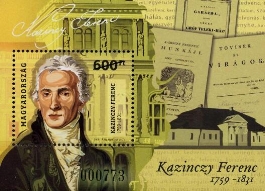FAMOUS HUNGARIANS: 250TH ANNIVERSARY OF FERENC KAZINCZY’S BIRTH
Date of issue: 2 April 2009

Ferenc Kazinczy (Érsemjén, 17 October 1759 – Széphalom, 23 August 1831) was a writer, poet, the leading figure of the language reform, and a member of the Hungarian Academy of Sciences.
His schooling brought him much pleasure and provided intellectual stimuli in his life. He read both the classics of antiquity and contemporary literature. His first work was published in 1775 and then, encouraged by his teachers, he translated and published an early work by György Bessenyei, Der Amerikaner. In 1777 he travelled to Pest and Vienna. He completed his legal studies in 1779 and became an articled clerk. 1780 was a year of a deep spiritual crisis for him, which he managed to overcome with the help of Enlightened literature. In 1784 he became a freemason and was admitted to the Virtuous World Citizens Lodge in the Hungarian town of Miskolc. He was a county court judge for the counties of Sáros and Abaúj, and the honorary deputy notary for Zemplén county. Between 1786 and 1791, as the inspector of schools for ten counties in the north east of Hungary, he supported and helped the realisation of the educational policy of Joseph II. After his Masonic Lodge was disbanded, he joined the Order of the Rose, which promoted self-education. Kazinczy was involved in founding the literary magazine, Magyar Museum, in 1788 and then he published his own periodical, Orpheus, in 1790.
After being implicated in a conspiracy led by Ignác Martinovics, he was arrested and sentenced to death for high treason in 1794. However, this was commuted by royal decree and he was imprisoned in Spielberg, Kufstein and Mukachevo. After he was released, he lived amidst family disputes and hard financial conditions. He married Zsófia Török in 1804 and moved to Széphalom in 1806. Kazinczy managed his estate independently but was always deeply in debt. In spite of this, he devoted most of his time to his great goal in life of renewing and improving the Hungarian language. Until the 1820s Széphalom was the centre of Hungarian literary life. New writers, such as Pál Szemere, Ferenc Kölcsey, Dániel Berzsenyi and András Fáy, first presented their manuscripts to Kazinczy, awaiting his criticism and opinion. It was due to his agitation that the language reform became a matter of national interest. He extended his work to phraseology, semantics, sentence structure and expressions for linking words.
From 1825 he was active in the preparations for the foundation of the Hungarian Learned Society, later the Academy of Sciences. In April 1831 he set off on a long journey, working on travel descriptions. A cholera epidemic was ravaging Northern Hungary, and although he returned home directly before the area was quarantined, Kazinczy regrettably could not escape from the disease and became a victim of the epidemic. (Source: http://enciklopedia.fazekas.hu; http://hu.wikipedia.org)
The numbered stamp block shows a portrait of Ferenc Kazinczy, while the
frame depicts a montage of some important stages of his life: the
building of the Hungarian Academy of Sciences, his writings, and his
residence at Széphalom. The background printing features phrases and
words related to his activity as a language reformer as well as his
signature. The main motif on the first day cover for the block is a
detail of the building of the Hungarian Academy of Sciences and the
postmark employs a composition referring to literature.
SO
Order code: 2009090030011 (block) - 2009090060012 (FDC)
Date of issue: 2 April 2009
Printed by Állami Nyomda
Designed by Zsolt Vidák
Imperforated size of the block: 90 x 65 mm. Perforated size of the stamp in it: 40 x 31.5 mm.
100,000 copies issued.

